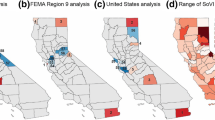Abstract
In this paper, we develop a Bayesian Hierarchical Spatial Lag of X (SLX) spatial econometric model to examine the relationship between contextual factors associated with violence levels in Mexico over the period 2005–2010, a period in which violence in the country reached record levels. We provide local spillover estimates of relevant covariates at both levels of the hierarchy, i.e., the municipal and state levels in Mexico. We also provide a methodology to compare relevant models regarding the proper specification of the spatial weight matrix in these models.
Similar content being viewed by others
Notes
The only exception is the level 2 variable joint operations, which is a dummy variable.
References
Chamlin MB, Cochran JK (2005) Ascribed economic inequality and homicide among modern societies toward the development of a cross-national theory. Homicide Stud 9(1):3
Castillo JC, Mejía D, Restrepo P (2013) Illegal drug markets and violence in Mexico: The causes beyond Calderón, Versión electronica. http://cie.itam.mx/SEMINARIOS/MarzoMayo_2013/Mejia.pdf. 3 Oct 2013
Dell M (2015) Trafficking networks and the Mexican drug war. Am Econ Rev 105(5):178–179
Dube A, Dube O, García-Ponce O (2013) Cross-border spillover: US gun laws and violence in Mexico. Am Pol Sci Rev 107(03):397
Dube O, Garcia-Ponce O, Thom K (2014) From maize to haze: agricultural shocks and the growth of the mexican drug sector. Center for global development, Working paper 355
Escalante F, Alvarado A, Serrano M (2010) Panorama del homicidio en México. Esquema de análisis territorial 1990–2007, XV Seguridad nacional y seguridad interior. Los grandes problemas de México. México, DF: El Colegio de México, pp 301–30
Fajnzlber P, Lederman D, Loayza N (2002) Inequality and violent crime. JL Econ 45:1
Fajnzylber P, Lederman D, Loayza N (1998) Determinants of crime rates in Latin America and the world: an empirical assessment. World Bank Publications, Washington
Flores M, Rodriguez-Oreggia E (2014) Spillover effects on homicides across Mexican municipalities: a spatial regime model approach. Rev Reg Stud 44(3):241–262
Freeman R (1995) The labor market. In: Wilson J, Petersilia J (eds) Crime: public policies for crime control. ICS Press, San Francisco, CA, pp 171–192
Freeman RB (1996) Why do so many young American men commit crimes and what might we do about it? J Econ Perspect 10(1):25–42
Goodman C, Marizco M (2010) US firearms trafficking to Mexico: new data and insights illuminate key trends and challenges, Woodrow Wilson International Center for Scholars, Mexico Institute and University of San Diego Trans-Border Institute, Working Paper Series on US-Mexico Security Cooperation
Jacobs D, Richardson AM (2008) Economic inequality and homicide in the developed nations from 1975 to 1995. Homicide Stud 12(1):28
LeSage JP (2014) What regional scientists need to know about spatial econometrics, Available at SSRN 2420725
LeSage J, Pace RK (2009) Introduction to spatial econometrics. CRC Press, Boca Raton
LeSage JP, Pace RK (2014) The biggest myth in spatial econometrics. Econometrics 2(4):217
Lochner L, Moretti E (2004) The effect of education on crime: evidence from prison inmates, arrests, and self-reports. Am Econ Rev 94(1):155–189
Messner SF, Raffalovich LE, Sutton GM (2010) Poverty, infant mortality, and homicide rates in cross-national perpsective: assessments of criterion and construct validity. Criminology 48(2):509
Osorio J (2012) Democratization and Drug violence in Mexico. Conflict and Violence at Yale University, Program on Order
Osorio J (2013) The contagion of drug violence: spatio-temporal dynamics of the mexican war on drugs. Working paper, Cornell University
Payan T (2006) The three US-Mexico border wars: drugs, immigration, and homeland security. Greenwood Publishing Group, Santa Barbara
Ratcliffe JH (2010) The spatial dependency of crime increase dispersion. Secur J 23(1):18
Raudenbush SW, Bryk AS (2002) Hierarchical linear models: applications and data analysis methods, vol 1. Sage, London
Reuter P (2009) Systemic violence in drug markets. Crime Law Soc Change 52(3):275
Rodriguez-Oreggia, Flores M (2014) Structural factors of homicides under army interventions in local mexico. Working paper, Escuela de Gobierno y Transfromacion Publica
Seelke CR (2010) Gangs in Central America. DIANE Publishing, Collingdale
Snyder R, Duran-Martinez A (2009) Does illegality breed violence? Drug trafficking and state-sponsored protection rackets. Crime Law Soc Change 52(3):253
Spiegelhalter DJ, Best NG, Carlin BP, Van Der Linde A (2002) Bayesian measures of model complexity and fit. J R Stat Soc Ser B (Stat Methodol) 64(4):583
Zimring FE, Hawkins G (1997) Crime is not the problem: lethal violence in America. Oxford University Press, New York




